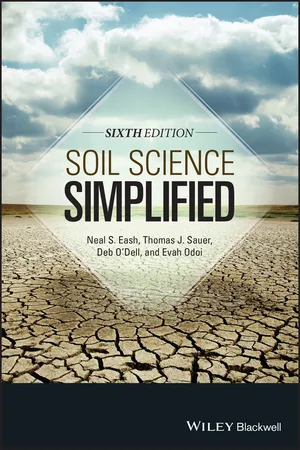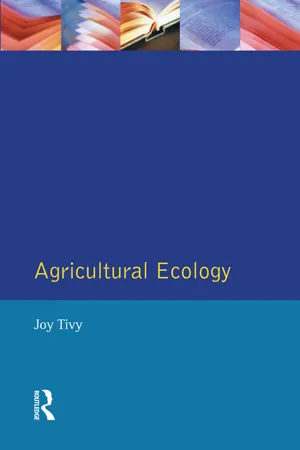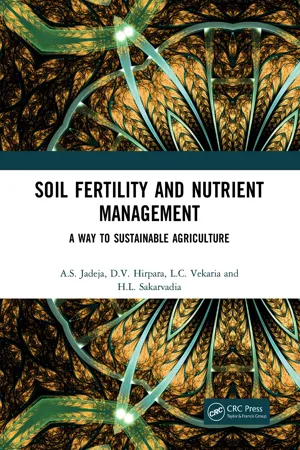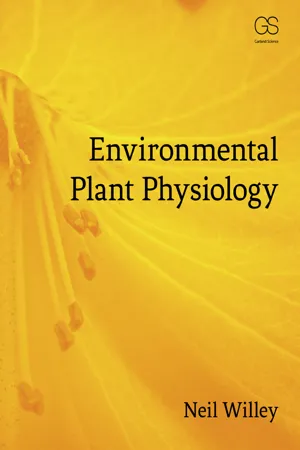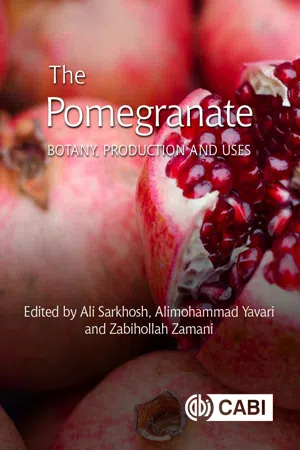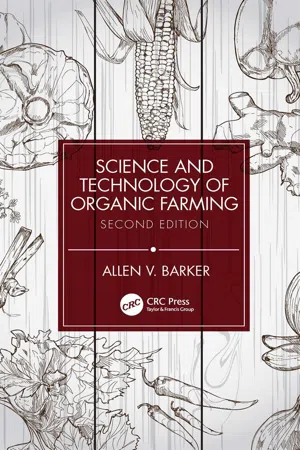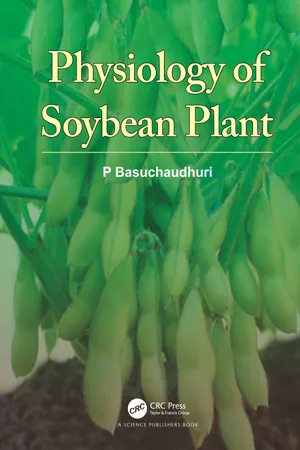Biological Sciences
Soil Nutrients
Soil nutrients are essential elements and compounds that support plant growth and development. They include macronutrients such as nitrogen, phosphorus, and potassium, as well as micronutrients like iron, zinc, and copper. These nutrients are absorbed by plant roots from the soil and play a crucial role in various physiological processes within the plant.
Written by Perlego with AI-assistance
Related key terms
12 Key excerpts on "Soil Nutrients"
- eBook - ePub
- Neal S. Eash, Thomas J. Sauer, Deb O'Dell, Evah Odoi, Mary C. Bratz(Authors)
- 2015(Publication Date)
- Wiley-Blackwell(Publisher)
Chapter 8 Soil Fertility and Plant NutritionWater, carbon dioxide, and certain chemical elements called plant nutrients are essential for plant growth. Water is supplied by either rainfall or irrigation, carbon dioxide from the atmosphere, and the essential plant nutrients from the soil, fertilizers, or other soil amendments.Soil Fertility
Soil fertility includes the ability of a soil to hold plant nutrients, the level of plant nutrients present, and the availability of the nutrients for uptake by plants. A soil that has a high level of essential nutrients available for use by plants is usually a productive soil if it also has sufficient soil water and if the crops are well managed. Plant nutrients exist in the soil in several different forms. They include the following:- Minerals. Examples include the feldspar group, which is the most abundant group of minerals in the rocks of the earth. Some are high in potassium and others in calcium. Nutrients are released from the minerals by weathering.
- Cations or anions. These are plant nutrients that exist on the surface of clay or humus. These surfaces are called the exchange complex and are positive or negative. They attract, hold, and exchange the cations or anions (see Chapter 5 ).
- Chemical compounds. There are many chemical compounds that form in the soil. An example would be the formation of phosphorus complexes on the surface of calcium carbonate.
- Soluble ions. Numerous ions exist in the soil solution. Plants absorb a large portion of their essential nutrients from this source. This pool of nutrients is small, but can be readily replenished through cation exchange reactions and other buffering mechanisms.
- Organic matter
- eBook - ePub
- Joy Tivy(Author)
- 2014(Publication Date)
- Routledge(Publisher)
Chapter5
Nutrient cycling
The soil is the nutrient pool or reservoir from which, in both unmanaged and all but a few specialized agricultural systems, the nutrients essential for plant growth and development are drawn. Varying amounts of some fourteen elements are required. They include the macronutrients needed in relatively large and the micronutrients (or trace elements) in very small quantities. Of the former, the most important are nitrogen, phosphorus and potassium – the ‘Big Three’ – the primary fertilizer elements used in agriculture. The latter comprise iron, manganese, boron, molybdenum, copper, zinc, chlorine and cobalt and, with the exception of iron and manganese, occur naturally in small amounts in the soil.Table 5.1 Principal ionic forms of nutrients absorbed by cropsElement Cations Anions Macronutrients Nitrogen (NH4 )+ (ammonium) (NO3 )– (nitrate) Calcium Ca2+ – Magnesium Mg2+ – Potassium K+ – Phosphorus – – (SO4 )2– (sulphate) Micronutrients Copper Cu2+ – Iron Fe2+ – Manganese Mn2+ – Zinc Zn2+ – Boron – (BO3 )3– Molybdenum – (MoO4 )2– Chlorine – C1– Nutrient uptake, however, is dependent on the mineral element being availablei. e. in a chemical form that can be readily adsorbed by the plant root system – at or near the root-soil solution interface (Hillel, 1972). The available elements are those present in relatively simple soluble forms, either as anions in the soil solution or as cations capable ofbeing adsorbed, and hence retained, on the surface of the clayhumus colloidal complex (see Table 5.1 ). The amount of available nutrients and their ease of adsorption is also closely dependent on the physical as well as the chemical condition of the soil. On the one hand, the amount of available nutrients retained by the soil is determined by its texture and structure but, more particularly, by the cation exchange capacity of the colloidal complex. On the other hand, uptake can be affected by the ease with which the crop root system can develop laterally and vertically to exploit the soil. In addition, less soluble and hence less readily available nutrients occur in the soil in complex organic or inorganic compounds from which they may eventually be gradually released either by decomposition or by rock weathering as the case may be. In uncultivated soils most of the nitrogen, phosphorus and sulphur is held in the form of organic compounds and the proportion readily available (see Table 5.2 - eBook - ePub
Soil Fertility and Nutrient Management
A Way to Sustainable Agriculture
- A.S. Jadeja, D.V. Hirpara, L.C. Vekaria, H.L. Sakarvadia(Authors)
- 2021(Publication Date)
- CRC Press(Publisher)
2.2. BASIC SOIL -PLANT RELATIONSHIPS
Mineral Nutrients in the Soil: Mineral nutrients occur in the soil in both dissolved and bound form. Only a small fraction (less than 0.2%) of the mineral nutrient supply is dissolved in soil water. Most of the remaining i e , almost 98 % is either bound in organic form, humus and relatively insoluble inorganic compounds or incorporated in minerals. These constitute a nutrient reserve, which becomes available very slowly as a result of weathering and mineralization of humus. The remaining 2.0 % is adsorbed on soil colloids. The soil solution, the soil colloids and the reserves of mineral substances in the soil are in a state of dynamic equilibrium, which ensures continued replenishment of supplies of nutrient elements.Nutrient dynamics in the soil: Plant absorbs dissolved nutrients along with water from the soil solution through roots. Therefore, sufficient concentration of essential nutrients must be maintained in soil solution. But, there are different sites of nutrient reserve in soil viz. soil solution, exchange complex, minerals and organic matter etc. The ionic equilibration is maintained among them especially between soil solution and exchange complex. Thus, it is essential to know nutrient dynamics, the relationship between these nutrient reservoirs and important physical, chemical and biological processes that releases the nutrients in soil solution and consequently uptake by plants.The interaction of various physical, chemical and biological properties in soils controls plant nutrient availability. Understanding these processes and how they are influenced by environmental conditions during the growing season enables us to optimize nutrient availability and plant productivity.Fig. 2.2 Various dynamic soil processes influencing the nutrient availabilityNutrient supply to plant roots is a very dynamic process (Fig. 2.2 ). Plant nutrients are absorbed from the soil solution and release small quantities of ions (H+ , OH- and HCO3 ) back to the solution by plant roots (reaction 1 and 2). As a result several chemical and biological reactions occur to buffer or resupply the solution. Ions adsorbed to the surface of minerals desorbs from these surfaces to resupply the solution (reaction 3 and 4). Ion exchange (adsorption and desorption) in soil is an important reaction to plant nutrient availability. Soils also contain minerals that can dissolve - eBook - ePub
- Victor J. Kilmer(Author)
- 2018(Publication Date)
- CRC Press(Publisher)
The soil system is very complex as one can conclude from Chapters 2, 3, 4, 5, 8, and 9. These physical, chemical, and biological factors interact in the presence of climate to influence the availability, uptake, and utilization of essential nutrients or elements and hence the fertility of soil. Man’s objective in studying soil fertility is to determine action that can be taken to improve the nutrient availability and make soils more productive. In one situation that might mean draining the soil to improve it as a medium in which roots can grow, while in another it may be determining how much fertilizer containing various essential elements must be added to supply a crop with adequate nutrition for optimum production in a given environment.Many excellent books have been written on soil fertility, fertilizers and plant nutrition, and their interrelated aspects. There are general books on soils and soil-plant relationships as related to soil fertility.1 -4 Soil fertility is is intimately linked to fertilizer use.5 -9Specific books or journals on the individual essential elements required by plants as related to soils, crops, and fertilizer use have been published on phosphorus,10 potassium,11 -13 magnesium,14 -16 and calcium.17 The benefits of liming in soil fertility have been covered in a book edited by Pearson and Adams.18 The micronutrient role in soil fertility and fertilizer use has been discussed in depth in books edited by Mortvedt et al.19 and Nicholas and Egan.20 In-depth discussions of mineral and plant nutrition are included in books edited or authored by Stewart,21 Arnon,22 and Mengel and Kirkby.23For the reader searching for more detail than is possible in this chapter, the above will be helpful. However, readers must be mindful that a steady flow of new research and published journal articles continues to broaden the scope and documentation on soil fertility, fertilizer, and plant nutrition on the soils of the world. - eBook - ePub
- Neil Willey(Author)
- 2018(Publication Date)
- Garland Science(Publisher)
Chapter 7Essential and Beneficial Elements
The uptake of mineral elements is influenced in particular by the availability of N and P, and by salinity and soil pH.Key concepts
• Terrestrial life depends on plants mining a suite of essential nutrient elements from the soil.• In terrestrial ecosystems, biomass production and quality are often nutrient limited.• Under conditions of fluctuating nutrient availability, concentrations in plants are homeostatically controlled.• Some non-essential elements can have beneficial effects on plants.• S is involved in many plant–environment interactions, and is often a useful fertilizer.• K fertilization enhances crop growth but has modest effects on global K cycles.• Ca and Mg availability can affect crops and has widespread effects on ecosystems.• Chronic lack of macronutrients can lead to anatomical and morphological changes in roots.• Plant–microbe interactions aid nutrient capture in chronically infertile unmanaged ecosystems.• The concentrations of many elements in plants are interrelated.Terrestrial plants evolved to mine the soil for an ancient suite of available elements
The most important resources for plants are generally light, CO2 , H2 O, N, and P, so the availability of these has significantly influenced the evolution of terrestrial ecosystems. In addition, however, there are numerous other elements that are essential for plant growth, and several that are beneficial. The availability of these elements is currently frequently limiting to plant growth, and probably was so in the past. In unmanaged and managed terrestrial ecosystems the availability of these elements has consequences not only for plants but also for other organisms, because they too have an essential requirement for these elements, and for most organisms plant uptake from the soil is their ultimate source. Studies of watersheds - eBook - ePub
- FIFA(Author)
- 2006(Publication Date)
- CSIRO PUBLISHING(Publisher)
Figure 1.1 .Mineral nutrients taken up by plants from the soil are shown inTable 1.1 ,each with its chemical symbol. The major nutrients are used in greatest quantity by plants and usually become deficient first. The micro-nutrients are required in small amounts but they are just as important as the major nutrients. Plants must have them when and where they need them.Table 1.1 Mineral nutrients taken up by plants from soil.Major nutrients Micro-nutrients Nitrogen (N) Boron (B) Phosphorus (P) Chloride (Cl) Potassium (K) Copper (Cu) Calcium (Ca) Iron (Fe) Magnesium (Mg) Manganese (Mn) Sulfur (S) Molybdenum (Mo) Zinc (Zn) Five other elements – sodium (Na), cobalt (Co), vanadium (V), nickel (Ni) and silicon (Si) – have also been shown to be essential for the growth of some plants. These five nutrients are almost never deficient in the soil and problems are more often associated with excess or toxic levels. Still other elements, such as selenium (Se), are also essential for animal nutrition and are sometimes applied to the soil as a mixture with fertilizer.Soil texture and structure
Soil texture is dependent on how much sand, silt and clay is present. Soils are grouped into a number of textural classes, normally 11, which enables them to be clearly classified, rather than using a loose term such as a ‘light’ or ‘heavy’ soil. An example of how mechanical analysis of the soil is used to describe its texture is illustrated in Figure 1.2 , where the point shown describes a soil made up of 32% clay, 17% silt and 51% sand as being a clay loam.Aggregation of particles is the basis for soil structure. In the broadest sense it includes the size, shape and arrangement of soil particles and aggregates; the size, shape and arrangement of voids and spaces separating the particles and aggregates; and the combination of voids and aggregates into various types of structure. - J. J. Landsberg, S. T. Gower(Authors)
- 1997(Publication Date)
- Academic Press(Publisher)
Therefore, if forest ecosystems are to be managed on a sustainable basis, it is essential to understand (i) the natural processes regulating nutrient inputs, (ii) the transformations both within and between the soil and vegetation, and (iii) nutrient losses (Fig. 7.1). We also have to understand how these processes are affected by natural and anthropogenic disturbances. Figure 7.1 Schematic diagram showing the various components of the nutrient cycle of forests. The purpose of this chapter is to review the basic framework of forest nutrition, including the major sources of nutrient inputs to forests, the transfer of nutrients between the vegetation and soil, the internal recycling or redistribution and use of mobile nutrients (including the feedback mechanisms between the vegetation and soil), and the potential pathways for nutrient losses from forest ecosystems. The first part presents some basic concepts and principles; the remainder of the chapter draws on those concepts and principles to examine how various forest management practices and natural “disturbances” affect the biogeochemical cycles of forest ecosystems. Where possible, we compare contrasting forests ecosystems around the world. We have attempted to provide a balanced presentation, but the focus tends to be on nitrogen and, to a lesser extent, phosporus because these two nutrients have traditionally been perceived as the ones most commonly limiting forest growth, although this viewpoint is changing (Gosz, 1986). I The Essential Plant Nutrients and Ion- Exchange Capacity of Soils A Essential Plant Nutrients The mineral elements essential for plant growth can be divided into two categories based on the amounts required by plants (Salisbury and Ross, 1992): macro (carbon, hydrogen, oxygen, nitrogen, phosphorus, sulfur, calcium, magnesium, and potassium) and micronutrients (boron, chlorine, copper, iron, manganese, molybdenum, cobalt, and zinc)- eBook - ePub
Pomegranate, The
Botany, Production and Uses
- Ali Sarkhosh, Alimohammad Yavari, Zabihollah Zamani, Ali Sarkhosh, Alimohammad Yavari, Zabihollah Zamani(Authors)
- 2020(Publication Date)
- CAB International(Publisher)
Specific adsorption is a highly selective phenomenon (Mengel et al., 2001; Osman, 2013). Fig. 9.1. Availability of nutrients as influenced by soil pH. (Source: https://www.pda.org.uk/pda_leaflets) 9.4 Mineral Nutrients All nutritional elements are necessary for healthy growth and development, flowering and fruiting of plants. Macronutrients are required for synthesis and activity of organic compounds or used for osmoregulation and cellular pH maintenance. Micronutrients are the constituents of enzyme molecules and are involved in photosynthesis, cell membrane structure, and disease resistance or susceptibility. For example, sufficient amounts of Ca, B or Zn or an excess of nitrogen are very important in these cases. 9.4.1 Nutrient source and their availability in soil The distribution of plant mineral nutrients in a natural soil is extremely heterogeneous. Soil nutrient concentrations and availability in a pomegranate orchard may thus vary both spatially and temporally, which greatly affect the acquisition of nutrients by plant roots. There are several sources of nutrients for crop production as follows (Mengel et al., 2001; Osman, 2013): • soil organic matter (plant residues, microorganisms, etc.); • mineral fertilizers; • organic fertilizers; • release from parent rocks by weathering and release from fixed sites in clay minerals (e.g. K from illite); • atmospheric deposition; • N-fixation by specialized microorganisms. The use of chemical fertilizers is the most common and quick method to supply both macronutrients and micronutrients. Although chemical fertilizers have largely contributed to improved crop productivity, excessive use has led to environmental and groundwater pollution. Therefore, it is essential to optimize the application of chemical fertilizers to minimize their adverse environmental effects. Various methods have been proposed and tested to increase nutrient availability in soils - eBook - ePub
Northern Nut Growers Association Report of the Proceedings at the Thirty-Seventh Annual Report
Wooster, Ohio, September 3, 4, 5, 1946
- (Author)
- 2008(Publication Date)
- Perlego(Publisher)
Plants contain very often inorganic elements in a form in which they cannot be utilized. It is therefore quite easy to mistake their presence either as a toxicity symptom or as a high requirement, when as a matter of fact these elements are present due to conditions unfavorable to metabolism, and they remained in bark and leaves as end products, in an inert form. Rather than being transmitted from soils to plant, their functions may consist of the formation of enzymes, proteins, hormones, chlorophyll, antibodies, vitamins, in carbon assimilation. When they have served such purposes they are not likely to be present in plants in anything like the amounts or forms as present in soils. They may come into question as catalysts or bio-catalysts, as sources of energy for microorganism, from which their optimum effects have been secured when they are not transmitted at all, causing changes, but remaining themselves unchanged. They are essential in the sense that the elements composing soils, sea, atmosphere are constantly energized, changed and used over and over again to create plant, animal and human life. In this cycle nothing is lost, only changed from old to new generations.SummarySoil factors for tree growth are physical, chemical and biological. To control the organisms of soils and plants is probably the most difficult problem in microbiology. It is not wise to alternate neglect with feverish attention when blights or other pests become epidemic or threatening. They may be of a nutritional, preventable rather than curable nature. Pathology and tree nutrition may as well become a constant part of your activities.References to the Literature 1. BEESON, K. C. The Mineral Composition of Crops U.S.D.A. Bulletin No. 369. March, 1941 2. FEARON, W. R. A Classification of the Biological Elements Sci. Proc. Royal Dublin Soc. Vol. 20 No. 35. February, 1933 3. WISCHHUSEN, J. F. Minerals in Agricultural and in Animal Husbandry Manganese Research & Development Foundation Cleveland 10, Ohio 4. RODALE, J. I. The Organic Forest—Editorial Organic Gardening, Emmaus, Pa. April, 1945, pp. 4-9 5. SCARSETH, GEORGE D. Growing Bananas on Acid SoilsAgriculture in the Americas, Vol. IV. October, 1944, No. 10 6. RAYNER, M. C. and NEILSON-JONES, W. Problems of Tree Nutrition Faber and Faber, Lt. London 7. ROACH, W. A. Soil Fertility and Trace Elements Soil Conservation, Washington. October, 1945 Condensed in Farmer's Digest, Ambler, Pa. January, 1946 - eBook - ePub
- Allen V. Barker(Author)
- 2021(Publication Date)
- CRC Press(Publisher)
3 Requirements of Plants for Soil-Derived NutrientsThis chapter presents information on (1) the functions of nutrients in plants, (2) the effects of nutrients on plant growth and quality, (3) recognition of symptoms of deficiencies of nutrients, and (4) how to supply nutrients to plants. For most of the nutrients, specific metabolic functions in plants have been identified. Participation in these metabolic roles is a factor that makes an element essential. The function of all essential elements in plants is not known, but the fact that plants will not grow in the absence of the elements is evidence of their being plant nutrients. Because of the metabolic disorders associated with shortages of a nutrient, limitations in the supply of any nutrient may restrict plant growth, development, and yields and cause appearance of symptoms of deficiency. Often deficiencies of nutrients are expressed in lower quality of produce. Increasing the supply of the nutrient will enhance growth and yields within limits and will also have effects on crop quality, for example, developing green color in a leafy vegetable crop. However, supply of nutrients in excess of the needs of a crop may have an adverse effect on crop quality, often lowering quality or suppressing harvest yields.Severe shortages of nutrients usually lead to the development of symptoms of deficiency. Recognition of these symptoms is a useful way of identifying nutritional disorders in a crop. If the deficiency is detected in time, fertilization may restore crop productivity. If the deficiency is recognized too late for correction in the current crop, the grower is alerted that remedies need to be taken for the next season.Fertilizers are materials that carry plant nutrients to the soil or directly to crops. This chapter will present and evaluate organic and chemical fertilizers for each of the plant nutrients and will discuss practices that increase the nutrient-supplying capacity of soil. - eBook - ePub
- Graham Stirling, Helen Hayden, Tony Pattison, Marcelle Stirling(Authors)
- 2016(Publication Date)
- CSIRO PUBLISHING(Publisher)
Chapter 2
Soil physical, chemical and biological properties, and the key role of organic matter in promoting soil and plant health
Soils are not a uniform entity. They are formed from various types of rock and are weathered by different processes. Consequently, they possess a range of properties and are subject to quite different constraints. If farm managers are to minimise soil loss and degradation and maintain soil health in the long term, they must recognise that every soil is different, and develop management practices that are appropriate for the soil types on their farm. The introductory chapters of this book have been prepared with this goal in mind. They provide basic information on the characteristics and constraints that must be understood if soil is to be managed in a sustainable manner. This chapter provides a brief introduction to the mineral components of soil, and the physical, chemical and environmental factors that determine whether it is capable of supporting healthy, productive crops. The important role of the soil’s biological component is also mentioned, but the pests, pathogens and beneficial organisms that impact on crop production are covered in more detail in Chapters 3 and 4.Soil composition
Mineral particles are the most obvious component of soil, but air, water, organic matter and living organisms will also be present. The amount of each component varies with soil type and management but, in general, 45% of the soil is composed of mineral particles, 20–30% is air, 20–30% is water and 1–5% is living or dead organic matter (Fig. 2.1 ). The amount of air and water will change depending on how wet or dry the soil is, while the amount of organic matter varies with soil type, climate and the management system.Mineral particles
The mineral component of soil is made up of sand, silt and clay particles, sometimes referred to as the ‘primary soil particles’. These particles largely determine a soil’s physical characteristics and texture. Soils with predominantly clay particles are sometimes referred to as ‘heavy’ soils, whereas soils dominated by sand are considered to be ‘light-textured’. - eBook - ePub
- P Basuchaudhuri(Author)
- 2020(Publication Date)
- CRC Press(Publisher)
CHAPTER 6Plant Nutrition
Nutritional requirements of crops have always been of interest but more so now than ever because of changing economic and environmental dynamics in crop production. Increased demands for limited water supplies for uses other than agriculture, along with the resulting depletion of non-renewable water resources, higher energy and fertilizer costs, adoption of genetically modified crops, and climate change (Allen et al., 2012), alter the landscape of crop production. Concerns over agriculture’s contribution to increased water consumption and its possible contamination of water resource sources through current production practices also stimulate a need for more current information about the nutrient requirements of most of our agronomic crops.Deficiencies in N, P or S all result in a shift in dry matter allocation in favour of root growth (Ericsson, 1995). However, simple measurement of the relative biomass of the shoot and root fails to reveal the many subtleties of the roots’ response to changes in nutrient supply. Note, that it seems to be a general rule in plants that primary root growth is much less sensitive to nutritional effects than is the growth of secondary or higher-order roots.6.1 NitrogenThe development of N-fixing nodules on legume roots is a highly regulated process. The number of nodules on a root system is controlled by a mechanism called ‘autoregulation’, in which previously formed or forming nodules suppress the development of further nodules (Schultze and Kondorosi, 1998). Split-root experiments have established that autoregulation acts systemically and that the autoregulatory signal originates in the shoot (Kosslak and Bohlool, 1984).
Learn about this page
Index pages curate the most relevant extracts from our library of academic textbooks. They’ve been created using an in-house natural language model (NLM), each adding context and meaning to key research topics.
